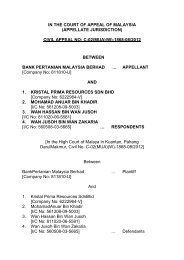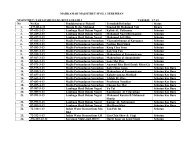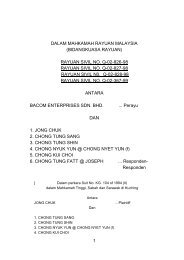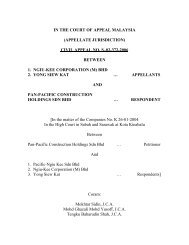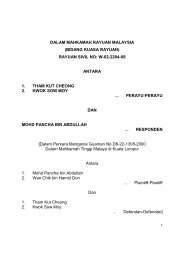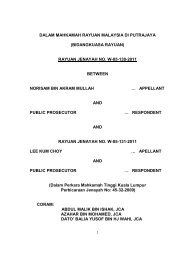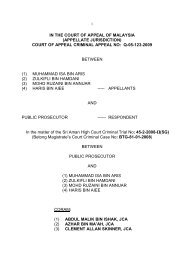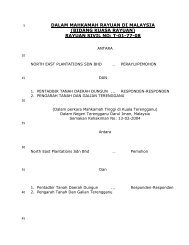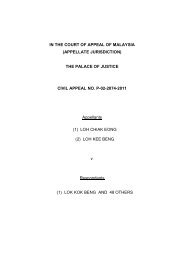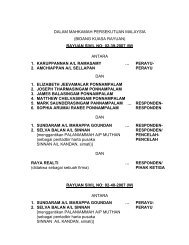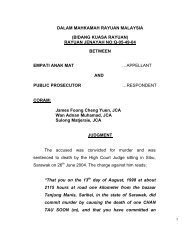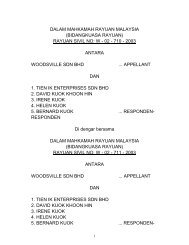09 – 54 –2004 antara khairuddin bin mohd yusuf
09 – 54 –2004 antara khairuddin bin mohd yusuf
09 – 54 –2004 antara khairuddin bin mohd yusuf
Create successful ePaper yourself
Turn your PDF publications into a flip-book with our unique Google optimized e-Paper software.
DALAM MAHKAMAH RAYUAN MALAYSIA<br />
(BIDANGKUASA RAYUAN)<br />
RAYUAN JENAYAH NO. W <strong>–</strong> <strong>09</strong> <strong>–</strong> <strong>54</strong> <strong>–</strong>2004<br />
ANTARA<br />
KHAIRUDDIN BIN MOHD YUSUF … PERAYU<br />
DAN<br />
PUBLIC PROSECUTOR … RESPONDEN<br />
(Di dalam Perkara Mahkamah Tinggi Kuala Lumpur<br />
No. WPRJ 42<strong>–</strong>8<strong>–</strong>1997<br />
Di Antara<br />
Khairuddin <strong>bin</strong> Mohd Yusuf<br />
Dan<br />
Public Prosecutor)<br />
Coram: Gopal Sri Ram, J.C.A.<br />
Tengku Baharudin Shah <strong>bin</strong> Tengku Mahmud, J.C.A.<br />
James Foong Cheng Yuen, J.C.A.<br />
Introduction<br />
DISSENTING JUDGMENT OF GOPAL SRI RAM, J.C.A.<br />
1. The appellant <strong>–</strong> I shall refer to him as the accused <strong>–</strong> was<br />
convicted of the offence of culpable homicide not amounting to<br />
murder under the first limb of section 304 of the Penal Code and<br />
sentenced to 18 years imprisonment. His appeal to the High Court<br />
was dismissed. He appealed to this Court and at the conclusion of<br />
arguments his appeal was dismissed by a majority decision. For<br />
reasons that will become apparent later in this judgment, I consider it<br />
my duty to enter my most vigorous dissent upon the result in this
case.<br />
The case against the accused<br />
2<br />
2. The nub of the prosecution’s case against the accused was that<br />
on 19 April 1995, between 7.45 p.m. and 9.00 p.m. he intentionally<br />
caused the death of one Rabeah bte Abdul Hamid (whom I shall refer<br />
to as “the deceased”) at a room in Wenworth Hotel, at Jalan Yew,<br />
Kuala Lumpur. The charge goes on to specify that the accused<br />
caused the deceased’s death by strangling her with the strap of her<br />
handbag. It was therefore imperative for the prosecution to prove <strong>–</strong><br />
at the end of the whole case <strong>–</strong> that the accused was present in the<br />
room at or about the material time.<br />
3. The evidence of circumstances adduced by the prosecution put<br />
at its highest disclosed the following points against the accused:<br />
(i) At about 9.00 a.m. on 19 April 1995, the<br />
deceased was seen by members of her family,<br />
namely, her husband, PW5, her son PW6 and her<br />
daughter PW12. They testified that she had a<br />
Rolex watch, some jewellery and cash of<br />
RM21,000 on her person. According to them, the<br />
jewellery was of sentimental value to the<br />
deceased. They said that she would therefore not<br />
readily part with them.<br />
(ii) The deceased was seen in the accused’s<br />
company, in the afternoon of the day in question.<br />
This was at about 4.00 p.m. at the Arab Malaysian
3<br />
Bank building along Jalan Raja Chulan. That is<br />
the evidence of PW13. The deceased ran a<br />
cafeteria at the building in question which the<br />
accused used to frequent.<br />
(iii) The accused was constantly in a financially<br />
straitened position.<br />
(iv) The accused had pawned the watch and<br />
jewellery in question with PW17 late on the night of<br />
19 April 1995.<br />
(v) The deceased’s body was discovered on the<br />
night of 20 April 1995. An examination of the<br />
room revealed head and pubic hairs. These were<br />
sent to the Chemist (PW22). He compared them<br />
with samples taken from the accused. The<br />
comparison was only visual, under a microscope.<br />
No DNA tests for comparison were done. PW22<br />
concluded from his mere visual examination that<br />
the hairs recovered at the scene were 75%<br />
physically similar to those taken from the person of<br />
the accused.<br />
4. Based on the foregoing circumstantial evidence the prosecution<br />
invited the sessions court to convict the accused. As I have already<br />
said, that invitation was accepted and the verdict at trial was affirmed<br />
as correct by the High Court. In my respectful view there are two<br />
main reasons why the conviction of the accused is unsafe and ought<br />
to be quashed. First, the totality of the evidence led by the
4<br />
prosecution, taken together with the evidence in the accused’s favour<br />
do not warrant an inference of guilt. Second, there was such a long<br />
delay in the production of the grounds of judgment by the sessions<br />
judge that resulted in an injustice to the accused. I will deal with<br />
each of these in turn.<br />
The failure to prove guilt<br />
5. I begin this part of the case by reminding myself that there is no<br />
added burden on the prosecution when it seeks to establish its case<br />
based on evidence of circumstances. See, Juraimi <strong>bin</strong> Husin v<br />
Public Prosecutor [1998] 1 MLJ 537. The position is the same as<br />
when it relies on direct evidence. It must, at the close of the whole<br />
case prove the accused’s guilt beyond a reasonable doubt. The<br />
danger <strong>–</strong> if it be a danger at all <strong>–</strong> of circumstantial evidence is that<br />
unlike direct evidence, it turns on the proper interpretation to be given<br />
to facts appearing in a set of circumstances. Where the result of the<br />
interpretation is the conviction of a person of a criminal offence, the<br />
interpretation must be such that it leaves no reasonable doubt in the<br />
mind of the court as to the guilt of an individual. The interpretation<br />
that is to be given to a set of circumstances is what lawyers refer to<br />
as “the drawing of an inference from proved or admitted facts”.<br />
6. In Sundram v Arujunan [1994] 3 MLJ 361, Edgar Joseph SCJ<br />
when delivering the majority judgment of the Supreme Court applied<br />
Lord Wright’s explanation in Caswell v Powell Duffryn Associated<br />
Collieries Ltd [1940] AC 152 of what a reasonable inference is in the<br />
sense used by Lord Macmillan in Jones v Great Western Railway<br />
(1930) 144 LT 194:
5<br />
“Inference must be carefully distinguished from<br />
conjecture or speculation. There can be no<br />
inference unless there are objective facts from<br />
which to infer the other facts which it is sought to<br />
establish. In some cases the other facts can be<br />
inferred with as much practical certainty as if they<br />
had actually been observed. In other cases the<br />
inference does not go beyond reasonable<br />
probability. But if there are no positive proved<br />
facts from which the inference can be made, the<br />
method of inference fails and what is left is mere<br />
speculation or conjecture.”<br />
7. In Jones v Dunkel (1959) 101 CLR 298, Kitto J said more or<br />
less the same thing in slightly different words:<br />
“One does not pass from the realm of conjecture<br />
into the realm of inference until some fact is found<br />
which positively suggests, that is to say provides a<br />
reason, special to the particular case under<br />
consideration, for thinking it likely that in that actual<br />
case a specific event happened or a specific state<br />
of affairs existed.”<br />
8. On the evidence adduced by the prosecution, two<br />
circumstances appear most damming of the accused. First, the<br />
finding at the scene of head and pubic hairs allegedly from the<br />
accused. Second, proof of accused’s possession of the deceased’s<br />
watch and jewellery which he pawned to PW17. So far as the first is
6<br />
concerned, I have employed the expression “allegedly from the<br />
accused” advisedly because the evidence of the chemist on the point<br />
falls short of establishing beyond a reasonable doubt that the hairs in<br />
question belong to the accused. Such proof would have been<br />
forthcoming is the samples had been subjected to DNA testing. But<br />
that did not happen here. Let me quote from the evidence of the<br />
chemist (PW22) under cross examination:<br />
“I cannot be definite in saying whether by this<br />
examination that a particular hair belonged to that<br />
particular person. I can only say that it is similar<br />
to that person’s hair. Yes, I did laboratory<br />
examination of the hairs which include microscopic<br />
examination.<br />
Put: In laboratory examination which includes<br />
microscopic examination of hair it may be possible<br />
to say that it cannot belong to a particular<br />
individual but it cannot be opined whether that hair<br />
particularly belongs to him/her?<br />
A: In my examination it can rule out persons<br />
who have completely different characteristics. But<br />
on the other hand persons with similar characters<br />
could be included and therefore I said could be<br />
similar. I must clarify that I said ‘similar’ and not<br />
‘same’, which mean one or more persons of the<br />
same group possessing similar characteristics.”<br />
I now quote from his re-examination:
7<br />
Q: How probable would it be that the hair found<br />
at the scene of the crime matches with the<br />
accused’s hair?<br />
A: I would say that it would depend on the<br />
characteristics that match and since about 75% of<br />
the characteristics match therefore it is 75% likely<br />
that the sample hair came from the specimen hair.”<br />
9. In my judgment the evidence of the chemist does not meet the<br />
level of proof called for by the law. It does not establish the fact that<br />
the hairs found at the scene of the crime were in fact those of the<br />
accused. In the absence of such a fact, it is mere conjecture that the<br />
accused was in the room in question. And I think it relevant in this<br />
context to quote the following passage from Field on Expert<br />
Evidence (4 th edn) p. 278:<br />
“While conducting the autopsy doctor had found<br />
some hair-sticking to the hand of the deceased<br />
which had been collected by him and kept in two<br />
packets and the same doctor had also collected<br />
hairs from the head of the accused when he<br />
examined him on 6 th January, 1979, and the report<br />
of the Chemical Examiner was that on microscopic<br />
examination where it is noticed that the hairs<br />
sticking to the hand of the deceased and collected<br />
from the head of the accused might be of similar<br />
origin, the report of the Chemical Examiner is not<br />
conclusive. In Modi's Medical Jurisprudence and
8<br />
Toxicology, Twentieth Edition, page 107, it has<br />
been stated that by laboratory examination of<br />
hairs, it would be possible to say that it cannot<br />
belong to a particular individual, but it cannot be<br />
opined whether it definitely belong to him.”<br />
10. There is another point about the chemist’s evidence that is in<br />
the accused’s favour. It is this. Nowhere in his evidence did the<br />
chemist allude to the kind of tests he carried out on the hairs before<br />
arriving at his conclusion of similarity. This made it unsafe for the<br />
sessions judge to rely on PW22’s evidence. In Himangshu Pahari v<br />
State (1986) Cri. LJ 622, the accused were charged for robbery and<br />
murder. Part of the evidence against the accused was that hairs<br />
were found at the scene were morphologically to the sample hairs<br />
taken from the person of the accused. The accused was convicted<br />
and appealed. In the course of delivering the judgment of the High<br />
Court of Calcutta Sankar Battacharyya J made the following<br />
observation:<br />
“After the appellant was taken into police custody<br />
the Investigating Officer took samples of his scalp<br />
hairs by com<strong>bin</strong>g and sent the hairs to the<br />
Forensic Science Laboratory for comparison with<br />
the hairs found in the deceased’s palm and at<br />
other places inside the flat On examination and<br />
comparison by the Senior Scientific Officer (P.W.<br />
18) the hairs found adhering to the blade- of the<br />
Rampuria knife seized from the deceased’s flat
9<br />
were, found morphologically to be similar to the<br />
sample hairs of the appellant (report <strong>–</strong> Ext. 15).<br />
Though the learned trial Judge accepted the report<br />
of the Senior Scientific Officer, on scrutiny of his<br />
evidence, we-consider it unsafe to act upon the<br />
report It has been elicited in his cross-<br />
examination that he did not measure the diameters<br />
of the shafts of the hairs or their length did not take<br />
impression of the cuticles of the hairs, did not, note<br />
the shapes, appearance and the colours of the<br />
hairs or the directions of the pointing out of the<br />
hairs. The science of comparison of hairs has<br />
not yet reached perfection like the science of<br />
comparison of finger prints. Where therefore<br />
all the tests were not meticulously carried our,<br />
it would be unsafe to rely upon the report. We<br />
therefore, leave out of our consideration the report<br />
of the Senior Scientific Officer (Ext. 15).”<br />
[Emphasis added].<br />
11. No doubt, in Himangshu Pahari v State, the insufficiency of<br />
proper examination was elicited under cross examination. But that<br />
does not make an iota difference. At the end of the day it is for the<br />
prosecution to prove its case beyond a reasonable doubt. The<br />
prosecution is not entitled to rely on inadequacies in the conduct of<br />
the defence to support a conviction that is patently unsafe. So here<br />
the sessions court ought to have taken into account this important
10<br />
fact operating in the accused’s favour. The failure on its part to do<br />
so has occasioned a miscarriage of justice.<br />
12. Next, there is the pawning of the watch and jewellery. By itself<br />
it is not proof that the accused committed the crime. But that fact<br />
does not stand by itself. There is the accused’s evidence explaining<br />
how he came to be in possession of the items in question. He said<br />
that he had received financial help from the deceased on previous<br />
occasions. That is not an improbable statement given the fact that<br />
members of the deceased’s family who gave evidence confirmed that<br />
the deceased had helped her friends and members of her family.<br />
When the evidence is read in its totality I am unable to avoid the<br />
irresistible conclusion that the deceased had very strong feelings for<br />
the accused. They met frequently. The accused was no stranger to<br />
the deceased’s children. There was therefore no evidential basis to<br />
support the conclusion that the accused committed the crime with<br />
which he was charged.<br />
13. As far as the law is concerned, I need only refer to three<br />
authorities. In Bhikha Gober v Emperor AIR 1943 Bom 458, Sir<br />
John Beaumont CJ said:<br />
“In the present case in the absence of eye<br />
witnesses we have no evidence whatever to<br />
connect the accused with the murder. It is<br />
obvious that somebody else might have committed<br />
the murder, and the accused might .have acquired<br />
the ornaments from that person; or he might have<br />
robbed the deceased, and somebody might have
11<br />
subsequently murdered her. The mere fact that<br />
he produced, shortly after the murder,<br />
ornaments which were on the murdered<br />
woman is not enough, in my opinion, to justify<br />
an inference that the accused must have<br />
committed the murder.” [Emphasis added].<br />
14. In In re Thangaswamy AIR 1963 Mad 476, the accused was<br />
charged with the murder of one Nacharammal, the deceased. It was<br />
in evidence that the accused and the deceased were known to each<br />
other and that a few hours after her death the accused had attempted<br />
to sell her jewels. The accused was convicted of murder and<br />
appealed. The High Court quashed the conviction.<br />
Anantanarayanan J delivering the judgment of the court said:<br />
“We are therefore of the opinion that the analysis<br />
of the evidence in this case amounts to this. As a<br />
person who was acquainted with the deceased,<br />
and who had knowledge that she habitually wore<br />
certain jewels, the accused had a possible<br />
opportunity and motive to commit the crimes of<br />
robbery and murder. But there is absolutely<br />
nothing to connect the movements of the accused<br />
with those of the victim, either that morning or after<br />
the crime.”<br />
Here too, there is not a shred of evidence to show that the accused<br />
entered the hotel in the company of the deceased or was seen<br />
entering the room in which her body was discovered. To
12<br />
recapitulate, it is the evidence of the prosecution that the deceased<br />
was alone when she checked into the hotel.<br />
15. Lastly, in Sanwat Khan v State of Rajasthan AIR 1956 SC <strong>54</strong>,<br />
Mahajan J said:<br />
“Here, there is no evidence, direct or<br />
circumstantial, that the robbery and murder formed<br />
parts of one transaction. It is not even known at<br />
what time of the night these events took place. It<br />
was only late next morning that it was discovered<br />
that the Mahant and Ganpatia had been murdered<br />
and looted. In our judgment, Beaumont, C. J.,<br />
and Sen J. in Bhikha Gober v Emperor, AIR 1943<br />
Bom 458 (B) rightly held that the mere fact that an<br />
accused produced shortly after the murder<br />
ornaments which were on the murdered person is<br />
not enough to justify the inference that the accused<br />
must have committed the murder.<br />
There must be some further material to connect to<br />
accused with the murder in order to hold him guilty<br />
of that offence. Our attention was drawn to a<br />
number of decisions which have been summed up<br />
in a Bench decision of the Allahabad High Court in<br />
State v. Shankar Prasad AIR 1952 All 776(C), in<br />
some of which a presumption was drawn of guilt<br />
from the circumstance of possession of stolen<br />
articles soon after a murder. We have examined
13<br />
these cases and it appears to us that each one of<br />
these decisions was given on the evidence and<br />
circumstances established in that particular case<br />
and no general proposition of law can be deduced<br />
from them.<br />
In our judgment no hard and fast rule can be laid<br />
down as to what inference should be drawn from a<br />
certain circumstance. Where, however, the only<br />
evidence against an accused person is the<br />
recovery of stolen property and although the<br />
circumstances may indicate that the theft and<br />
the murder must have been committed at the<br />
same time it is not safe to draw the inference<br />
that the person in possession of the stolen<br />
property was the murderer. Suspicion cannot<br />
take the place of proof. [Emphasis added.]<br />
16. Quite apart from what I have discussed thus far, there are other<br />
facts in the accused’s favour. There is, in the first place, the fact that<br />
there were injuries on the deceased’s arm. The suggestion that was<br />
being made was that an item of jewellery had been forcible removed<br />
from the deceased. But no skin or tissue of the deceased was found<br />
under the nails of the accused’s fingers. In the second place, no<br />
witness gave evidence that he or she had seen the accused at the<br />
hotel or in its vicinity. In the third place, there was some evidence<br />
from within the prosecution case itself that the accused had been with<br />
PW17 at or about the time the deceased was killed. The prosecution
14<br />
tried to explain this away by contending that PW17 did not give<br />
precise evidence establishing an alibi in the accused’s favour. But<br />
the point missed is that this is the very witness whose evidence it was<br />
the prosecution was relying on to establish that the accused had had<br />
in his possession the deceased’s jewellery and watch after the killing<br />
had taken place.<br />
17. Now, you cannot have that. Because it is blowing hot and<br />
cold. It cannot be that PW17 was correct when he gave the<br />
approximate time at which the accused pawned the watch and<br />
jewellery but could not be relied upon at the same time as to the other<br />
fact, namely that the accused was with him during the time frame<br />
when the deceased was killed. He was obviously a witness of truth<br />
and put forward by the prosecution as such. He was a disinterested<br />
witness as a plain reading of his evidence reveals. He made no<br />
attempt to varnish the truth. His evidence shows no leaning or bias<br />
in the accused’s favour. The sessions court ought to have read his<br />
evidence in its proper context and given due consideration to the<br />
doubt reasonably raised by it as to the identity of the accused as the<br />
person who committed the crime. Thus, an inherent weakness in the<br />
prosecution’s case went unnoticed in both courts below thereby<br />
resulting in a miscarriage of justice.<br />
18. It follows that none of the facts bearing heavily in the accused’s<br />
favour were ever considered by the trial court. This is a non-<br />
direction amounting to a serious misdirection. It is clear that in the<br />
present instance there was no proper evaluation of the evidence by<br />
the sessions judge. Evaluation of evidence is not confined to a
15<br />
consideration of the evidence against an accused; it includes<br />
evidence that is favourable to him as well. This was not done. In<br />
my judgment the sessions judge erred in the handling of the facts. It<br />
is a well established principle that an error by the trial court in the<br />
handling of the facts is a ground for appellate intervention. See,<br />
Alcontara v Public Prosecutor [1996] 1 MLJ 2<strong>09</strong>; Chow Kok<br />
Keong v Public Prosecutor [1998] 2 MLJ 337. This aspect of the<br />
case was, with respect, overlooked by the High Court at the<br />
intermediate appeal. This Court cannot let such a state of affairs<br />
pass. It amounts to a failure of justice. And justice is, of course,<br />
justice according to the law.<br />
19. As Hegde J. said in Krishna Murthy v Abdul Subban [1965] 1<br />
Cr LJ 565, 576:<br />
“One of the contents of natural justice, which is so<br />
much valued, is the guarantee of a fair trial to an<br />
accused person. A fair trial is as important as a<br />
just decision. Neither the one nor the other can<br />
be sacrificed. Sacrifice of the one, in the<br />
generality of cases, is bound to lead to the<br />
sacrifice of the other. The two are closely<br />
interlinked.”<br />
20. When this Court hears a criminal appeal, the question that we<br />
have to ask ourselves is this. Has the appellant on the given facts of<br />
a particular case lost a chance fairly open to him to be acquitted<br />
because of a misdirection on the substantive or procedural law or an<br />
error in the handling of the facts by the trial court? If that question
16<br />
receives an affirmative answer, then there has been occasioned a<br />
miscarriage of justice. To quote Fullagar J in Mraz v the Queen<br />
(1955) 93 CLR 493, 514:<br />
“[E]very accused person is entitled to a trial in<br />
which the relevant law is correctly explained to the<br />
jury and the rules of procedure and evidence are<br />
strictly followed. If there is any failure in any of<br />
these respects, and the appellant may thereby<br />
have lost a chance which was fairly open to him of<br />
being acquitted, there is, in the eye of the law, a<br />
miscarriage of justice. Justice has miscarried in<br />
such cases, because the appellant has not had<br />
what the law says that he shall have, and justice is<br />
justice according to law. It is for the Crown to<br />
make it clear that there is no real possibility that<br />
justice has miscarried.”<br />
It is to be noted that the above quoted authorities were applied by a<br />
Full Bench of the Federal Court in Tunde Apatira & Ors v Public<br />
Prosecutor [2001] 1 MLJ 259.<br />
21. I now return to consider the totality of the circumstances and<br />
see if they satisfy Lord Wright’s test in Caswell v Powell Duffryn. I<br />
must say after due consideration that they do not. At best they raise<br />
a suspicion against the accused. But suspicion however strong can<br />
never take the place of proof. And as Doraiswamy Raju J said on<br />
behalf of the Supreme Court of India in Ashish Batham v State of<br />
Madhya Pradesh AIR 2002 SC 3206:
17<br />
“Realities or truth apart, the fundamental and basic<br />
presumption in the administration of criminal law<br />
and justice delivery system is the innocence of the<br />
alleged accused and till the charges are proved<br />
beyond reasonable doubt on the basis of clear,<br />
cogent, credible or unimpeachable evidence, the<br />
question of indicting or punishing an accused does<br />
not arise, merely carried away by heinous nature<br />
of the crime or the gruesome manner in which it<br />
was found to have been committed. Mere<br />
suspicion, however, strong or probable it may<br />
be is no effective substitute for the legal proof<br />
required to substantiate the charge of<br />
commission of a crime and graver the charge<br />
is greater should be the standard of proof<br />
required. Courts dealing with criminal cases at<br />
least should constantly remember that there is a<br />
long mental distance between may be true and<br />
must be true and this basic and golden rule only<br />
helps to maintain the vital distinction between<br />
conjectures and sure conclusions to be arrived at<br />
one the touch stone of a dispassionate judicial<br />
scrutiny based upon a complete and<br />
comprehensive appreciation of all features of the<br />
case as well as quality and credibility of the<br />
evidence brought on record.” [Emphasis added].
18<br />
Reading this passage again, I find its appropriateness to the present<br />
case to be apposite.<br />
22. It is with these matters in mind that I asked the learned Deputy<br />
who appeared before us whether she considered there was sufficient<br />
evidence to support the conviction in this case. She very properly<br />
and entirely in keeping with well established tradition agreed that<br />
there was none. She is to be commended for her forthrightness. It<br />
is a refreshing change from the usual course of things which has<br />
been my experience in this court when counsel, whether they be from<br />
the chambers of the Public Prosecutor or the general Bar seek to<br />
defend the indefensible. In the light of the very important and honest<br />
response from the learned deputy, I find it impossible to support a<br />
decision to dismiss the appeal. Such a course, in my view, strikes at<br />
the very heart of the criminal justice system.<br />
The delay point<br />
23. In order to understand my reasons under this head, a recital of<br />
some of the chronology is called for.<br />
24. The accused was first produced and charged in court as long<br />
ago as 5 June 1995. His trial began very soon thereafter, on 7<br />
December 1995. The trial concluded with the accused being<br />
convicted on 27 February 1997. The sessions court’s grounds of<br />
judgment were made available on 22 January 2002. So, all in all it<br />
took the best part of 6 years for this case to conclude in the sessions<br />
court. I say “conclude” because there is no conclusion of a trial until<br />
a written judgment giving the reasons for the court’s decision is given<br />
in accordance with statute. As Ismail Khan J (later CJ Borneo) said
19<br />
in Balasingham v Public Prosecutor [1959] MLJ 193, when<br />
referring to a case tried by the sessions court:<br />
“The trial Court is under a statutory obligation<br />
under section 308 of the Criminal Procedure Code<br />
to transmit to the Appellate Court the grounds of<br />
decision which convey to my mind a reasoned<br />
judgment on the facts and the law not merely the<br />
conclusion arrived at. The advantage of a<br />
“speaking” judgment needs no emphasis.”<br />
25. Now, although our Constitution does not expressly guarantee<br />
the right to a speedy trial, such a right has indeed been read into the<br />
supreme law by our courts. In Ooi Ah Phua v Officer-in-Charge,<br />
Criminal Investigations Kedah/Perlis [1975] 1 MLJ 93, Hashim<br />
Yeop A Sani J, when construing Article 5 of the Constitution read<br />
such a right into that Article. He said:<br />
“A speedy trial is certainly an unwritten right of<br />
every person accused of an offence.”<br />
On appeal, the Federal Court affirmed his decision. See, Ooi Ah<br />
Phua v Officer-in-Charge, Criminal Investigations Kedah/Perlis<br />
[1975] 2 MLJ 198. In particular, Suffian LP who delivered the<br />
judgment of the court expressly approved of the learned judge’s<br />
above quoted view.<br />
26. In my judgment, a failure by our justice system to speedily and<br />
effectively deliver justice to a litigant constitutes an infringement of<br />
the equal protection clause in Article 8(1) of the Constitution. When
20<br />
considering the speed of the delivery of justice by the justice system<br />
our focus should be on the quality of the justice provided rather than<br />
the reasonableness of the State’s efforts to provide it. Further, a<br />
distinction must be drawn between cases where there has been a<br />
delay in the delivery of judgment and a delay in affording a hearing.<br />
In the former, the delay must be of such a nature as to render the<br />
conviction unsafe in criminal case.<br />
27. These propositions emerge from two recent decisions of the<br />
Judicial Committee of the Privy Council. The first is Boodhoo v<br />
Attorney General of Trinidad and Tobago [2004] UKPC 17, where<br />
Lord Carswell said:<br />
“Their Lordships would observe, however, that<br />
whereas the question of the resources of the state<br />
may be material when deciding if a delay was<br />
unreasonable, when one is considering the issue<br />
of protection of the law under a provision such as<br />
section 4(b) (see, eg, Mungroo v The Queen<br />
[1991] 1 WLR 1351), the focus of the court<br />
should be on the quality of justice provided<br />
rather than the reasonableness of the state’s<br />
efforts to provide it. [Emphasis added].<br />
28. He then made this observation:<br />
“It is hardly necessary to say that different<br />
considerations apply to cases of delay in giving<br />
judgment from those concerned in cases of delay<br />
in affording a hearing. In the latter type of case
21<br />
the evidence which is to be adduced may no<br />
longer be reliable or the testimony of essential<br />
witnesses may not be obtainable. In the former,<br />
of which Goose v Wilson Sandford & Co, (The<br />
Times, 19 February 1998) provides an example,<br />
delay may have so adversely affected the quality<br />
of the decision that it cannot be allowed to stand.<br />
It may be established that the judge's ability to deal<br />
properly with the issues has been compromised by<br />
the passage of time, for example if his recollection<br />
of important matters is no longer sufficiently clear<br />
or notes have been mislaid. These are, however,<br />
extreme cases, ordinarily associated with<br />
inordinately long periods of delay.”<br />
29. In a later passage Lord Carswell added this important rider:<br />
“In their Lordships’ opinion delay in producing a<br />
judgment would be capable of depriving an<br />
individual of his right to the protection of the law,<br />
as provided for in section 4(b) of the Constitution of<br />
Trinidad and Tobago, but only in circumstances<br />
where by reason thereof the judge could no longer<br />
produce a proper judgment or the parties were<br />
unable to obtain from the decision the benefit<br />
which they should. For example, on an<br />
application to prevent the threatened abduction of<br />
a child, any delay in giving judgment might deprive
22<br />
both the applicant and the child of the benefit<br />
which the legal remedy was there to provide.<br />
Their Lordships do not think it profitable to attempt<br />
to define more precisely the circumstances in<br />
which this may occur or to specify periods of delay<br />
which may bring about such a result, since cases<br />
vary infinitely and each has to be considered on its<br />
merits, applying this principle.”<br />
30. You will see the reference in the foregoing passage to section<br />
4(b) of the Constitution of Trinidad and Tobago. For completeness,<br />
the material part of that subsection reads as follows:<br />
“4. It is hereby recognised and declared that in<br />
Trinidad and Tobago there have existed and shall<br />
to continue to exist without discrimination by<br />
reason of race, origin, colour, religion or sex, the<br />
following fundamental human rights and freedoms,<br />
namely:-<br />
(b) the right of the individual to equality<br />
before the law and the protection of the<br />
law.”<br />
The striking similarity between section 4(b) and Article 8(1) of our<br />
Constitution is to be noted. Any dissimilarity in language between<br />
the two provisions is a distinction without a difference. Since the<br />
equal protection clause in the Constitution of Trinidad and Tobago<br />
admits of an implied right to a speedy trial it is difficult to reason why<br />
Article 8(1) of our Constitution should not also do so.
23<br />
31. The second case is Campbell v Hamlet [2005] UKPC 19.<br />
That was also an appeal from Trinidad & Tobago. It concerned a<br />
case involving disciplinary proceedings against an Attorney at Law.<br />
The Attorneys at Law Disciplinary Committee had taken 8 years to<br />
deliver its judgment. The Board of the Privy Council described the 8<br />
year delay as “highly reprehensible, indeed unforgivable”. But it<br />
refused to interfere because the delay had had no adverse effect<br />
upon the appellant. Any injustice had been suffered by the<br />
complainant who had died before judgment. Lord Brown of Eaton-<br />
under-Heywood who delivered the Advice of the Board said:<br />
“As for the argument that the Committee's delay<br />
adversely affected their determination, there is<br />
nothing in this point either. There are, of course,<br />
cases where such an argument should properly<br />
succeed. Goose v Wilson, Sandford & Co, The<br />
Times [19 February 1998] (Court of Appeal (Civil<br />
Division) transcript no. 196 of 1998) was one such.<br />
As Lord Carswell explained in giving the Board’s<br />
judgment in Boodhoo v Attorney General of<br />
Trinidad and Tobago [2004] 1 WLR 1689, 1694,<br />
Goose provides an example of where:<br />
‘Delay may have so adversely affected the<br />
quality of the decision that it cannot be<br />
allowed to stand. It may be established<br />
that the judge’s ability to deal properly with<br />
the issues has been compromised by the
24<br />
passage of time, for example if his<br />
recollection of important matters is no<br />
longer sufficiently clear or notes have been<br />
mislaid.’ (para 11).<br />
The present case, however, is very different from<br />
Goose on the facts. The delay here was, of<br />
course, considerably longer. But whereas in<br />
Goose the judge’s ability to decide the case was<br />
clearly compromised, here it was not. Here the<br />
Committee had the full transcripts of all the<br />
evidence and it was well able to provide a<br />
reasoned decision in reliance upon them. What is<br />
striking, indeed, is that only two criticisms are<br />
made of the Committee’s reasoning (or lack of it)<br />
and that each of these turns entirely upon reading<br />
the Committee’s judgment in the light of the<br />
transcript. In other words, even if the criticisms<br />
were soundly based, they would not be explicable<br />
by reference to the delay.”<br />
32. That brings me to the case of Goose v Wilson, Sandford & Co<br />
[1998] EWCA Civ 245. That was a case where the trial judge had<br />
delayed 20 months in giving judgment in a civil matter. The Court of<br />
Appeal held that the delay had prejudiced a fair trial of the case and<br />
therefore ordered a re-trial. Peter Gibson LJ who delivered the<br />
judgment of the court to which the other members of the panel had<br />
contributed said:
25<br />
“A judge’s tardiness in completing his judicial task<br />
after a trial is over denies justice to the winning<br />
party during the period of the delay. It also<br />
undermines the loser’s confidence in the<br />
correctness of the decision when it is eventually<br />
delivered. Litigation causes quite enough stress,<br />
as it is, for people to have to endure while a trial is<br />
going on. Compelling them to await judgment for<br />
an indefinitely extended period after the trial is over<br />
will only serve to prolong their anxiety, and may<br />
well increase it. Conduct like this weakens public<br />
confidence in the whole judicial process. Left<br />
unchecked it would be ultimately subversive of the<br />
rule of law. Delays on this scale cannot and will<br />
not be tolerated. A situation like this must never<br />
occur again.<br />
ll3. Because of the delay in giving judgment, it has<br />
been incumbent on us to look with especial care at<br />
any finding of fact which is now challenged. In<br />
ordinary circumstances where there is a conflict of<br />
evidence a judge who has seen and heard the<br />
witnesses has an advantage, denied to an<br />
appellate court, which is likely to prove decisive on<br />
an appeal unless it can be shown that he failed to<br />
use, or misused, this advantage. We do not lose<br />
sight of the fact that the judge had transcripts of
26<br />
the evidence, as well as very extensive written<br />
submissions from counsel. But the very fact of the<br />
huge delay in itself weakened the judge’s<br />
advantage, and this consideration had to be taken<br />
into account when we reviewed the material which<br />
was before the judge. In a case as complex as<br />
this, it is not uncommon for a judge to form an<br />
initial impression of the likely result at the end of<br />
the evidence, but when he has come to study the<br />
evidence (both oral and written) and the<br />
submissions he has received with greater care, he<br />
will then go back to consider the effect the<br />
witnesses made on him when they gave evidence<br />
about the matters that are now troubling him. At a<br />
distance of 20 months, Harman J. denied himself<br />
the opportunity of making this further check in any<br />
meaningful way.”<br />
33. It is to be noted that in Goose v Wilson a delay of 20 months in<br />
giving judgment was castigated in harsh terms. In Boodhoo v<br />
Attorney General of Trinidad and Tobago, evidence was put in to<br />
show the logistical problems faced by the justice system in that<br />
jurisdiction in delivering speedy justice. Not dissimilar considerations<br />
may obtain in our jurisdiction. But even taking into account the<br />
conditions peculiar to this country, I must say that the delay of 5 years<br />
in the present case; being one that concerns a very serious charge; is<br />
inexcusable. The accused’s constitutional right to a speedy trial has
27<br />
been infringed. The suffering he has had to endure must be<br />
considerable. The present case is not in the nature of the kind of<br />
case the Privy Council had to deal with in either Boodhoo v<br />
Attorney General of Trinidad and Tobago or Campbell v Hamlet<br />
[2005] UKPC 19. Those were not criminal cases of the present type.<br />
They did not concern either the life or liberty of an individual.<br />
34. I think that in a case such as the present, we should continue to<br />
apply the following observation of Spenser Wilkinson J in Voon Chin<br />
Fatt v Public Prosecutor [1948-1949] MLJ Supp 131, 133:<br />
“The interval between notice of appeal and delivery<br />
of grounds of decision should, in such a case, be a<br />
matter of days, not weeks, much less months.<br />
Indeed there is a very good reason from the<br />
Magistrate’s point of view why grounds of decision<br />
should always be written as promptly as possible.<br />
The sooner, after hearing the witnesses the<br />
grounds of decision are written the clearer in the<br />
mind of the Magistrate who writes them will be all<br />
the details of the evidence, the demeanour of the<br />
witnesses and the general atmosphere of the case.<br />
Where delay occurs, not only have important<br />
details faded from the mind of the Magistrate who<br />
tried the case, but also additional work is involved<br />
as the whole case has to be studied afresh in order<br />
to bring the matter back to mind. In my opinion,<br />
the fact that no time limit is laid down by law for
28<br />
giving grounds of decision increases the<br />
responsibility of Judges and Magistrates to see<br />
that no undue delay occurs and that the spirit of<br />
the law rather than its letter is complied with.”<br />
35. I also think it useful to quote the comment by Gunn Chit Tuan J<br />
(later Chief Justice of Malaya) in TN Nathan v Public Prosecutor<br />
[1978] 1 MLJ 134. He is a judge whose views are entitled to great<br />
respect on any subject but particularly so in the area of the criminal<br />
law. This is what he said:<br />
“In the above-quoted case, the learned District<br />
Judge did not acknowledge the difficulty of<br />
remembering the impression which witnesses had<br />
made upon him, but the appellate court<br />
nevertheless held that the long delay of two years<br />
in delivering the grounds of judgment was<br />
unsatisfactory and had prejudiced the appellant in<br />
the appeal because in writing grounds of<br />
judgment so long after the hearing it is<br />
possible that the learned District Judge may<br />
have omitted to state something in those<br />
grounds which might have been favourable to<br />
the appellant. In the present case, I regret to<br />
note that a summary trial under the provisions of<br />
the Criminal Procedure Code had to take so long<br />
to complete and that the judgment was not signed<br />
until eleven months after conclusion of the trial.
29<br />
Moreover, the further delay of another two years<br />
before receiving the grounds of decision was most<br />
unsatisfactory and has prejudiced the appellant.”<br />
[Emphasis added.]<br />
36. So too here. There is every possibility <strong>–</strong> and I have<br />
demonstrated this earlier in this judgment <strong>–</strong> that the sessions judge<br />
omitted to consider points in the evidence that were in the accused’s<br />
favour. The delay in this case has therefore prejudiced the accused<br />
and rendered the conviction unsafe.<br />
Conclusion<br />
37. For the reasons already given, I am of the view that the appeal<br />
ought to have been allowed and the conviction quashed. I am aware<br />
that a heinous crime was committed. An innocent life was wantonly<br />
taken. And in a gruesome fashion. But we cannot as a court of law<br />
be swayed by these considerations to affirm a conviction which is<br />
unsafe and dispense with long established principles and rules that<br />
assure the integrity of the criminal justice system.<br />
38. Of course this dissenting judgment does nothing for the<br />
accused in the present case. I am fully conscious of that. But, as<br />
Khanna J said in Additional District Magistrate, Jabalpur v<br />
Shivakant Shukla AIR 1976 SC 1207:<br />
“As observed by Chief Justice Hughes, judges are<br />
not there simply to decide cases, but to decide<br />
them as they think they should be decided, and<br />
while it may be regrettable that they cannot always
30<br />
agree, it is better that their independence should<br />
be maintained and recognized than that unanimity<br />
should be secured through its sacrifice. A dissent<br />
in a court of last resort, to use his words, is an<br />
appeal to the brooding spirit of the law, to the<br />
intelligence of a future day, when a later decision<br />
may possibly correct the error into which the<br />
dissenting judge believes the court to have been<br />
betrayed.”<br />
39. For the reasons given by my learned brothers who form the<br />
majority, this appeal stands dismissed. The conviction and sentence<br />
are affirmed.<br />
Dated: October 6, 2005.<br />
Gopal Sri Ram,<br />
Judge, Court of Appeal,<br />
Malaysia<br />
Putrajaya<br />
Counsel for the appellant: Hazman Ahmad<br />
Solicitors for the appellant: Tetuan Raja Badrol Hazman<br />
Counsel for the respondent: Nurulhuda Nur’aini bt Mohd Noor<br />
Solicitors for the respondent: Peguam Negara Malaysia



